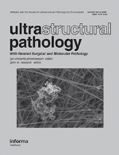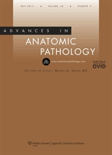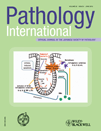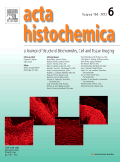
HISTOLOGY AND HISTOPATHOLOGY
Scope & Guideline
Empowering the Academic Community through Peer-Reviewed Excellence
Introduction
Aims and Scopes
- Histopathological Analysis:
The journal publishes studies that provide detailed histopathological evaluations of various tissues, contributing to the understanding of disease processes and their morphological manifestations. - Cancer Research:
A significant portion of the journal's articles focuses on the histopathological aspects of cancer, including tumor characterization, prognostic markers, and the molecular underpinnings of tumor progression. - Innovative Diagnostic Techniques:
Research on novel diagnostic approaches, including immunohistochemistry, molecular pathology, and histochemical methods, is a core area, highlighting advancements in the field. - Mechanistic Studies:
The journal supports studies elucidating the mechanisms of disease at the cellular and molecular levels, often linking histological findings to functional outcomes. - Translational Research:
There is a consistent emphasis on translational research that bridges laboratory findings with clinical applications, aiming to improve diagnostic and therapeutic strategies.
Trending and Emerging
- Molecular Pathology and Biomarkers:
There is an increasing trend towards studies that investigate molecular markers and genetic alterations in various cancers, underscoring the importance of molecular pathology in diagnosis and treatment. - Role of Non-coding RNAs in Cancer:
Emerging research on non-coding RNAs, particularly circular RNAs and long non-coding RNAs, is gaining traction, highlighting their roles in tumorigenesis and metastasis. - Response to Therapeutic Interventions:
Research focusing on histopathological changes in response to various therapeutic interventions, including chemotherapy and immunotherapy, is on the rise, reflecting a shift towards understanding treatment efficacy. - Inflammation and Immune Response in Pathology:
There is a notable increase in studies exploring the relationship between inflammation, immune responses, and histopathological changes, particularly in cancer and chronic diseases. - 3D Histological Techniques:
Innovations in three-dimensional histological techniques and imaging are emerging as a significant trend, enhancing the understanding of tissue architecture and pathology.
Declining or Waning
- Traditional Histopathology Techniques:
There is a noticeable decline in studies solely relying on conventional histopathological techniques without integration of molecular or genetic analyses, suggesting a shift towards more comprehensive, multifaceted approaches. - General Pathology without Specific Focus:
Research articles that provide broad, non-specific pathological insights are becoming less frequent, indicating a preference for studies that address specific diseases or conditions with detailed histopathological correlations. - Histopathology of Rare Conditions:
The publication of studies on rare or less common conditions appears to be decreasing, possibly due to the growing focus on prevalent diseases and conditions that have more significant clinical implications.
Similar Journals

Medical Molecular Morphology
Transforming Research into Therapeutic Advances.Medical Molecular Morphology, published by SPRINGER JAPAN KK, stands as a significant resource in the fields of medicine and molecular biology, bridging critical insights between histological studies and modern therapeutic approaches. With an ISSN of 1860-1480 and E-ISSN of 1860-1499, this journal has evolved since its inception in 1996 and has continued to provide a platform for innovative research through 2024, establishing its relevance particularly in the realms of medical pathology and molecular morphology. Although categorized as Q3 in Medicine (miscellaneous) and Q4 in Molecular Biology per the 2023 quartiles, the journal's unique contributions cannot be understated, as evidenced by its Scopus rankings, which place it in the 52nd percentile for Pathology and 19th percentile for Molecular Biology. The journal’s mission focuses on disseminating valuable findings that enhance the understanding of cellular and molecular structures and their implications in health and disease. As access options are not currently open access, it remains essential for professionals and researchers to consider the journal's contributions as they pursue academic growth and impactful research in these dynamic fields.

ULTRASTRUCTURAL PATHOLOGY
Elevating the Standards of Pathological ScholarshipULTRASTRUCTURAL PATHOLOGY is a prestigious academic journal published by Taylor & Francis Inc, focusing on the intricate and detailed aspects of pathology as well as forensic medicine since its inception in 1980. With an ISSN of 0191-3123 and an E-ISSN of 1521-0758, this journal provides a vital platform for researchers and professionals to disseminate innovative findings pertinent to both clinical and experimental pathology. Despite not being an open-access journal, its contributions are critical within its categories, positioned at the Q3 quartile in Pathology and Forensic Medicine and Q4 in Structural Biology as of 2023. The journal's reputation is further underscored by its Scopus rankings, placing it in the 41st percentile for Pathology and 15th percentile for Structural Biology, indicating a competitive standing in these fields. ULTRASTRUCTURAL PATHOLOGY aims to foster rigorous scholarly discourse and advance knowledge through the publication of original research articles, reviews, and case studies, making it an essential resource for academics, practitioners, and students engaged in the evolving domains of pathology and structural biology.

Malaysian Journal of Pathology
Unveiling the intricacies of pathology since 1979.Malaysian Journal of Pathology, published by the MALAYSIAN JOURNAL PATHOLOGY, stands as a pivotal resource in the fields of pathology and medicine, contributing rich insights since its inception in 1979. This peer-reviewed journal, based in Malaysia, is dedicated to disseminating original research, review articles, and case studies that advance the understanding of disease mechanisms and diagnostics. With a current impact factor reflecting its ranked positioning—Q4 in Cell Biology, Q4 in Histology, and Q3 in both Miscellaneous Medicine and Pathology & Forensic Medicine—this journal serves as an essential platform for researchers, clinicians, and students alike. Although it operates without open access, its scholarly rigor and contributions are well recognized, holding ranks such as #84 in Pathology and Forensic Medicine according to Scopus. The Malaysian Journal of Pathology is committed to fostering innovation and excellence in medical research, making it an invaluable tool for professionals seeking to stay abreast of significant advancements in the pathology domain.

ADVANCES IN ANATOMIC PATHOLOGY
Elevating Standards in Pathological Research.ADVANCES IN ANATOMIC PATHOLOGY is a leading peer-reviewed journal dedicated to the field of anatomical pathology, published by LIPPINCOTT WILLIAMS & WILKINS. With an impressive impact factor and consistent ranking in the Q1 category for both Anatomy and Pathology and Forensic Medicine, it serves as an essential resource for researchers, clinicians, and students alike. The journal has been a critical platform for disseminating significant findings and advancements in the discipline since its inception in 1996, boasting Scopus rankings of #1 in Anatomy and #11 in Pathology. While it does not provide open access, it maintains rigorous standards in the selection of articles, ensuring that published research reflects the latest developments and techniques in the field. As we look toward 2024 and beyond, ADVANCES IN ANATOMIC PATHOLOGY remains committed to advancing the science of pathology, fostering innovation, and enhancing clinical practice through impactful research.

PATHOLOGY INTERNATIONAL
Advancing the Boundaries of Pathology and Forensic MedicinePATHOLOGY INTERNATIONAL, published by WILEY, stands as a distinguished journal in the field of pathology and forensic medicine, serving as an essential resource for researchers, clinicians, and students alike. With its ISSN 1320-5463 and E-ISSN 1440-1827, PATHOLOGY INTERNATIONAL has established itself since its inception in 1951, navigating through an evolving landscape in medical science with insights and breakthroughs up to 2024. It holds a commendable Q2 ranking in both the Medicine (miscellaneous) and Pathology and Forensic Medicine categories, indicating its robust influence and quality within these fields, as evidenced by its placement in the 70th percentile of Scopus rankings. While currently not an open-access journal, it provides access options that ensure valuable research remains available to the academic community. PATHOLOGY INTERNATIONAL commits to advancing the discipline through pioneering research articles, comprehensive reviews, and expert opinions that push the boundaries of understanding in pathology, thereby supporting the enhancement of diagnostic and therapeutic practices.

Turkish Journal of Pathology
Elevating Standards in Pathology Research and PracticeTurkish Journal of Pathology, published by the Federation Turkish Pathology Society, stands as a vital platform for disseminating high-quality research in the field of pathology and forensic medicine. With an ISSN of 1018-5615 and an E-ISSN of 1309-5730, this journal has been an open-access publication since 2013, ensuring that cutting-edge findings are readily available to the global community. Based in Turkey, it aims to contribute significantly to the advancement of pathology as it converges from 2010 to 2024, currently holding a Q3 quartile ranking in its category according to 2023 metrics. As it ranks #129 out of 208 in the Scopus database for Medicine, Pathology, and Forensic Medicine, it offers researchers, professionals, and students invaluable insights and innovative studies that address critical developments in the field. The Turkish Journal of Pathology fosters collaboration and knowledge-sharing, making it an essential resource for anyone involved in pathology research and practice.

Romanian Journal of Morphology and Embryology
Connecting Innovations in Embryological StudiesRomanian Journal of Morphology and Embryology is a distinguished publication in the fields of Cell Biology, Developmental Biology, Embryology, and Pathology, published by EDITURA ACAD ROMANE. Established in 1991 and continuously evolving, this journal serves as a vital platform for disseminating research and advancements related to morphology and embryological studies. With an impressive range of quartile rankings in 2023, including Q3 in Embryology and Pathology, it reflects its growing significance and influence within the academic community. Although currently not open access, the journal provides crucial insights and findings valuable to researchers, practitioners, and students dedicated to enhancing their knowledge and exploring new innovations in the life sciences. The journal’s commitment to high-quality research further cements its role as a key resource for those involved in the intricate study of biological form and function.

ACTA HISTOCHEMICA
Unveiling the Secrets of Cells with Cutting-Edge HistochemistryACTA HISTOCHEMICA, a prestigious journal published by Elsevier GmbH, is dedicated to advancing the field of histochemistry and its applications within cell biology and medicine. With an ISSN of 0065-1281 and an E-ISSN of 1618-0372, the journal provides a critical platform for the dissemination of high-quality research findings and reviews, integral for both emerging and established scholars. Since its inception in 1954 and continuing through to 2024, ACTA HISTOCHEMICA has maintained a strong commitment to publishing significant advancements in histology and cell biology, as evidenced by its categorization in Q3 for Cell Biology and Histology, as well as Q2 in miscellaneous medicine for the year 2023. The journal ranks favorably in Scopus, holding the 27th rank in Histology and a 200th rank in Cell Biology, highlighting its importance to the academic community. With its headquarters in Munich, Germany, ACTA HISTOCHEMICA continues to attract contributions from global researchers, fostering an international dialogue essential for the growth of knowledge in histochemistry and related disciplines.

EUROPEAN JOURNAL OF HISTOCHEMISTRY
Transforming insights into impactful biomedical applications.European Journal of Histochemistry (ISSN: 1121-760X; E-ISSN: 2038-8306) is a distinguished peer-reviewed scholarly journal published by PAGEPRESS PUBL based in Italy. Since its inception in 1992 and with a commitment to Open Access since 2010, the journal has played a pivotal role in disseminating high-quality research in the fields of Histology, Biophysics, and Cell Biology. As of 2023, the journal holds a commendable position within the academic community, achieving Q2 rankings in Biophysics, Histology, and Medicine (miscellaneous), further highlighting its relevance and impact in these critical areas of research. Despite its HIndex not being specified, its Scopus rankings demonstrate the journal's competitive edge, particularly in Histology (Rank #33/62) and Biophysics (Rank #84/152). The journal aims to provide a platform for researchers to share innovative findings and contribute to the enrichment of knowledge in histochemical methodologies and their application to biomedical sciences. Its Open Access model ensures the broadest possible dissemination of research, making it an essential resource for researchers, professionals, and students alike who are engaged in the life sciences. For more information, visit the journal's webpage hosted by PAGEPRESS PUBL.

HISTOPATHOLOGY
Championing Rigorous Scholarship in PathologyHISTOPATHOLOGY is a premier scholarly journal published by WILEY, targeting the fields of histology, pathology, and forensic medicine. With an ISSN of 0309-0167 and an E-ISSN of 1365-2559, this esteemed journal has maintained a strong academic presence since its inception in 1977. Boasting an impressive Q1 ranking in crucial categories such as Histology and Pathology, it ranks 13th out of 208 in Pathology and Forensic Medicine, and 5th out of 62 in Histology, reflecting its high impact and relevance within the scientific community. HISTOPATHOLOGY serves as a critical platform for disseminating significant research findings, reviews, and advancements in the diagnostic and therapeutic aspects of pathology. Although it does not operate under an open access model, its rigorous peer-review process ensures that published articles uphold the highest standards of scientific integrity. Scholars and practitioners alike benefit from the insights shared in this journal, as it aims to bridge the gap between laboratory science and clinical practice, fostering innovation and enhancing our understanding of disease mechanisms.